Random Reviews: Spawn: Origins Collection (vol. 1) (The Image Review-lution, Part 2)
This series' clever concept and Todd McFarlane's striking visuals can't make up for a frenetic feast of lukewarm dialogue smothered in grimy darkness
—by Nathan on October 20, 2023—

Last "Random Reviews" post, we examined the first four issues of Rob Liefeld’s Youngblood, which kicked off what I am lovingly referring to as "The Image Revolution." I likened those initial issues to a time capsule, an artifact allowing us a look into the past and a glimpse into the mind of a creator no longer working the way a corporate colossus like Marvel wanted him to work. Simplistic the story is, and aggravating the art may be to some, but you cannot deny the historical weight of those issues.
In Youngblood #3, during a press conference, Youngblood "Home Team" leader Shaft is asked by reporters (who are clever visual nods to Clark Kent and Lois Lane) about the appearance of a few other costumed characters, specifically "the dragon," "the vigilante," and "the phantom." "The dragon," we can easily assume, is Erik Larsen’s Savage Dragon, a character I intend on discussing in the next post. "The vigilante" appears to be a reference to ShadowHawk, a Batman-esque nightstalker who I’ll touch on a few blogs from now. But "the phantom," an eerie, wraith-like individual haunting the streets of New York, deserves discussion now.
For this phantom is a man…and something other than human.
Spawn: Origins Collection (vol. 1)
Writer: Todd McFarlane
Penciler: Todd McFarlane
Inker: Todd McFarlane
Colorists: Steve Oliff, Reuben Rude, and Olyoptics
Letterer: Tom Orzechowski
Issues Collected: Spawn #1-6
Volume Publication Date: May 2019 (new printing)
Issue Publication Dates: May 1992, July-November 1992
Publisher: Image Comics
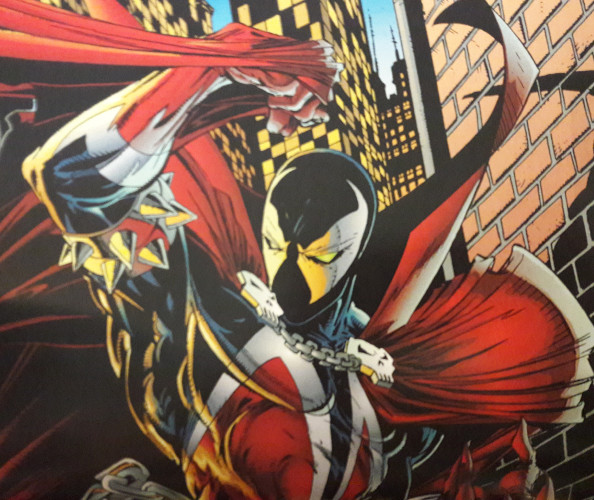
When it was originally published in 1992, Spawn #1 set the record as the bestselling creator-owned issue of all time, at 1.7 million copies sold. Though not outselling Todd McFarlane's previously record-breaking first Spider-Man issue, the sales numbers for Spawn #1 feel like a testament to the comics fans devoted to McFarlane, whether it was through his work on the Incredible Hulk alongside Peter David, his Amazing Spider-Man stint with David Michelinie, or his Spider-Man run.
In my reviews of McFarlane’s work, I’ve been routinely critical of his writing capabilities. The man is an artist, first and foremost, and making the transition to writing while maintaining penciling and inking duties can be no mean feat. I don’t envy McFarlane’s task at juggling so many variables in creating his stories, but I also don’t doubt that we’d receive much the same material were McFarlane only providing dialogue.
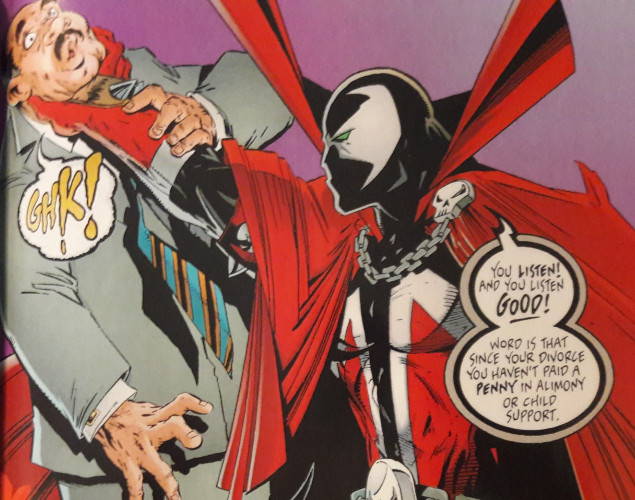
I entered this volume intrigued by Spawn’s central concept but guarding my expectations. I noted in my Youngblood review some of the context I selectively bring into my reading experience, and my prior encounters with McFarlane’s material tempered my excitement quite heavily. I expected the same cheesy dialogue, stilted metaphors, and awkward and ill-timed jokes, wrapped in a cursory examination of characterization in favor of high-octane action sequences tilted towards the morbid side.
Have you ever been disappointed to not be disappointed?
Several of McFarlane’s weaker writing practices exist throughout this volume, exemplified by his characters, from a demonic supervillain who thinks he’s far more clever than he actually is, to a squabbling pair of cops intended to provide comic relief, to a more powerful demon vomiting exposition that’s supposed to come across as foreshadowing. These first issues are not nearly as witty or hefty as they want to be. Whatever depth McFarlane is straining to inject is largely lost–a cackling demon, watching Spawn threaten a C.I.A. official, takes joy in the vigilante’s methods, taunting him: "Yes! Become evil! Vicious! Violent!" All subtlety is lost through the dialogue. It's a similar reading experience to Youngblood: come for the art, and stay for the art, because you won't be getting much else.
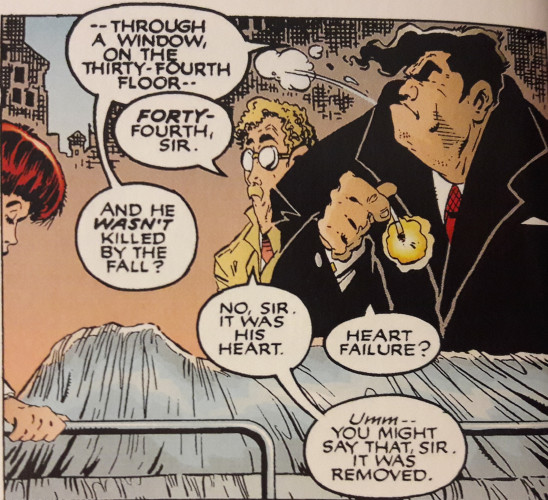
The central concept for Spawn, despite its lackluster execution, remains fairly strong: former military colonel Al Simmons is resurrected after making a deal with a demon and given incredible powers. These six issues lay out that backstory in pieces, thankfully, teasing the mystery of Simmons’ death and return instead of force feeding us his whole backstory immediately, which I appreciate. We’re left to wander with Simmons as he struggles to regain lost memories and determine what all has happened and how life has changed in the five years he’s been gone. Much of this volume follows Spawn as he wanders from alley to rooftop to alley, drowning in his sorrows as he struggles coming to terms with his new reality. McFarlane does achieve much of his plot development through exposition–he often uses "talking head" commentators similar to those in Frank Miller’s Dark Knight Returns–but the underlying concepts are at least interesting and carry you along, even if McFarlane’s grasp on narrative structure is weaker than appreciated.
Action sequences bound in from time to time, whether it’s Spawn dealing with a cluster of criminals or a cyborg villain taking down a military force. These scenes exemplify the over-the-top violence inherent in 90s comics, from the ways hearts are ripped out of chests to the blasts of demonic energy streaming across the page. Character designs only enforce this cheesy reliance on visual violence, and if you’re not at least bored with the generic, mechanical cyborg adversary, maybe you’ll get a laugh from the volume’s final image ("Image"?), a splash page of Spawn decked out in recently hijacked military hardware. Guy’s equipped with at least three guns, two knives, four grenades, a belt of ammo slung around his chest, and the bane of every 90s comic fan: pouches.
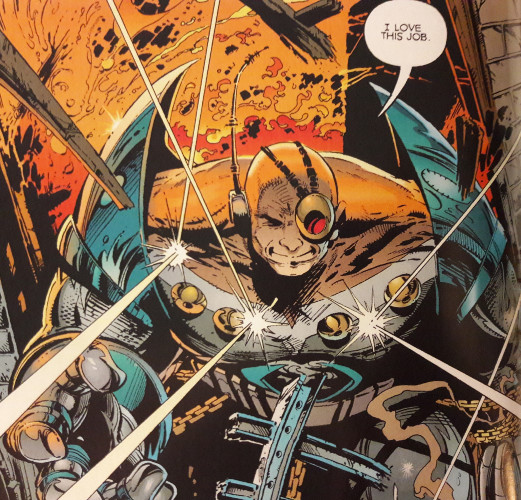
The volume reeks of McFarlane thinking like an artist first and a writer second. As we’ve established, art’s his bread and butter. Placing the guy in a position where he needed to think through the intricacies of a plot may not have been the best decision. There is a "visuals first" thought process applied to these issues that wonders how cool, radical, or extreme Spawn would look with three guns and a million pouches before ever asking why he would need so much equipment. A story reason is given, sure, but the sheer amount of weaponry hanging from the dude makes him look like a U.S. Army-themed Christmas tree with all the practicality of an overburdened Skyrim player.
I’ve said it before, but violence and darkness work when there are reasons for the violence and darkness to exist. Robert Kirkman's Invincible, though ridiculously gory, works well because of how the violence is applied in showing the impact acts like tearing a guy in half have on our central characters. This doesn’t happen in Spawn. Al Simmons, reborn as a masked vigilante, simply hurts, maims, and kills because McFarlane wants to push him past the line guys like Batman can’t cross, an admission McFarlane himself makes in part of an interview collected in this volume. McFarlane’s words hint at wanting to plumb the philosophical depths of the "hero as vigilante" or "hero with no moral qualms" debate and perhaps in further adventures Spawn more significantly wrestles with the issue. Here, the series often falls short or digs a little ways before abandoning the pit.
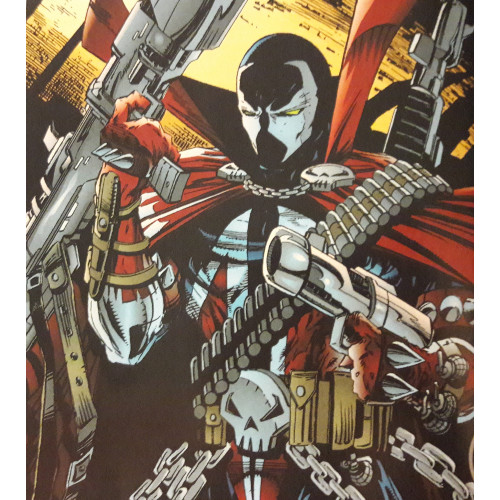
McFarlane’s fifth issue proves the temporary antithesis of this. We witness Spawn taking vengeance upon a murderous ice cream vendor recently released from a psychiatric institution. In comparison to the rest of the volume, McFarlane is more adept at convincing us of the issue’s dark themes, because he actually lets some thematic elements linger. Wrapped up in the story of this abominable purveyor of sweets are Spawn’s own human interests and the tenacity of the cops certain this vendor won’t walk a straight line following his release. The subject matter is, comparatively, darker and harder-hitting than elsewhere in the volume, yet it’s given the gravity it deserves. This isn’t demons blasting hellfire at each other or a cyborg taking out a massive gun like it's made out of toothpicks. Much like McFarlane’s "Perceptions" arc during his Spider-Man run, the confluence of different perspectives, grim scenarios, and justice mingle to create something more powerful, even if its influence is temporarily felt.
When McFarlane tells me to pay attention to Spawn, he loses me. His art and words shout so loud you fear you’ll go deaf from the clanging. Al Simmons may as well wear a sign around his neck, testifying his violent, no-nonsense tendencies. This isn’t Marvel, where the righteous Spider-Man will draw the Punisher away from murdering criminals; this isn’t even DC, where Batman may occasionally step across his own self-imposed moral lines before quickly skipping back to the safety of the other side. To quote McFarlane, even Batman "stops short of killing the bad guys, even though the bad guys are killers. Spawn can now go there." To hear McFarlane talk, you’d think he’d stumbled across the incredibly unique premise that superheroes, particularly vigilantes, can kill criminals…as if no one had played with or explored this idea previously. It’s been done, Todd, to death. The line’s already been crossed. You’re just lumping in another cape-cloathed killer.
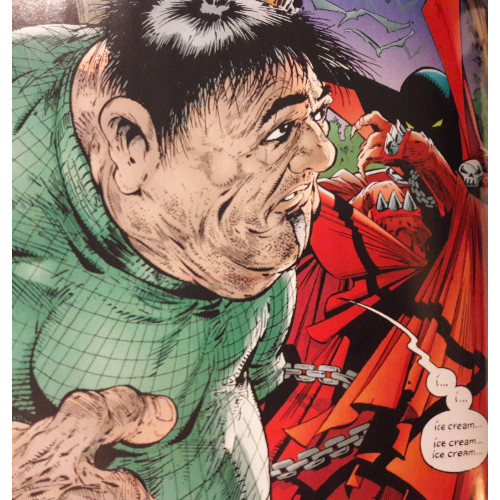
I don’t intend on picking up additional volumes of this series. As stated in my Youngblood review, this is a taste, a Spawn snack. And I’m left washing away the aftertaste. The self-importance rippling from these first issues, the seriousness with which McFarlane takes his creation, is frustrating. The self-aggrandizing of McFarlane–who, truthfully, does recognize he’s created a character that has been consistently published for a little over thirty years, which is no mean feat–further frustrates. I can understand passionately diving into an idea and wanting others to see what it’s all about. I can get developing a story and sharing it with others, to let them enjoy and process what you’ve created. There’s no harm in that. But Spawn–and, perhaps in some ways, the initial Image Comics experiment–feels like an ego boost for guys who were already at the top of their game.
I know that may clash with what I wrote before, about analyzing the narrative itself. And I did. And I walked away feeling hollow. Again, I’ll recognize that a mere six issues don’t begin to cover the saga of a character with over 300 appearances in his main series and that I brought some of my McFarlane-related baggage into the review. At the same time, I can recognize his talents, particularly his art, and I can recognize McFarlane feeling chained to the conceits of the age, particularly the abundance of weapons, violence, and cheesy dialogue. I can’t say I expected better.
But have you ever been disappointed to not be disappointed?